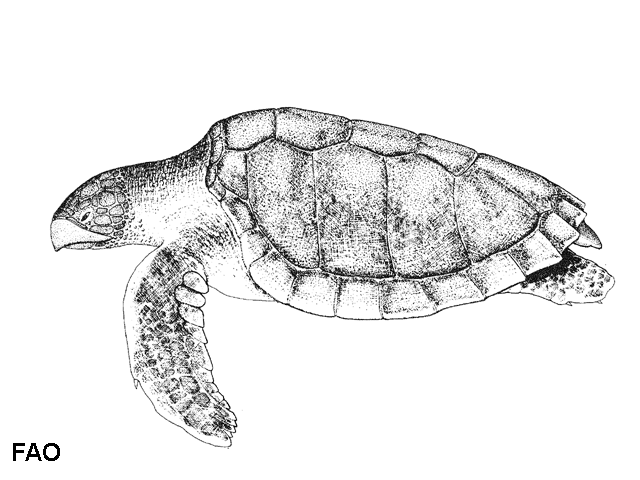| Cheloniidae (sea turtles) |
| 74.8 cm CL (male/unsexed); 65.7 cm CL (female); max.weight: 48 kg |
|
demersal; marine |
| Atlantic Ocean and the Mediterranean (Malta). |
|
Body mass lower than 50,000 g. Carapace of adults are nearly round. Head: moderate-sized; subtriangular. Hatchlings: longer carapace and larger head. As it grows, carapace changes its shape and becomes a little wider. Head with 2 pairs of prefrontal scales. Carapace: with 5 central, 5 pairs of lateral and 12 pairs of marginal scutes; bridge areas have 4 scutes. Each with a pore which is the opening of the Rathke’s gland. This gland plays a pheromonal role in maintaining the integrity of the massed nesting assemblage of females just off the beaches in which it releases an odoriferous substance before and during their arrival. One visible claw on fore flippers; hatchlings show two, in rear flippers 1 or 2 claws. Color: in adults, plain olive-grey dorsally, white or yellowish underneath; in hatchlings, jet black when wet; changes significantly with age; after 10 months, plastron is nearly white. |
| One of the smallest of the sea turtles. Usually inhabits sandy and muddy bottoms that are rich in crustaceans. A carnivorous species mostly feeds on crustaceans, mollusks, fishes and vegetable fragments. Mating season occurs from April to the end of July. Females are occasionally escorted or seen mating at the near surf area. This turtle are known to be day-time nesters and mass nesting takes place on windy days. The females lay eggs from 1.4 to 1.55 times each season with a number of 102 eggs per clutch. Incubation period lasts for 45 to 58 days depending on temperature and humidity. Commercial exploitation of this species is not allowed throughout its distribution range (Ref. 1397). Usually inhabits sandy and muddy bottoms that are rich in crustaceans (Ref. 1397). A carnivorous species that mostly feeds on crustaceans, mollusks, fishes, vegetable fragments and so on. |
|
Critically Endangered (CR); Date assessed: 14 January 2019 (A2bd) Ref. 123251)
|
|
|
Source and more info: www.sealifebase.org. For personal, classroom, and other internal use only. Not for publication.

